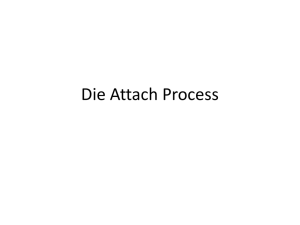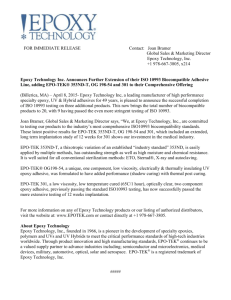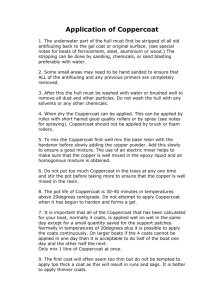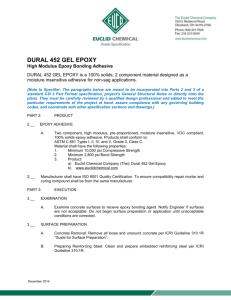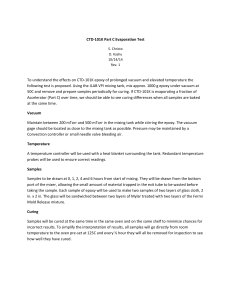Making Petrographic Thin Sections by machine mod 4
advertisement
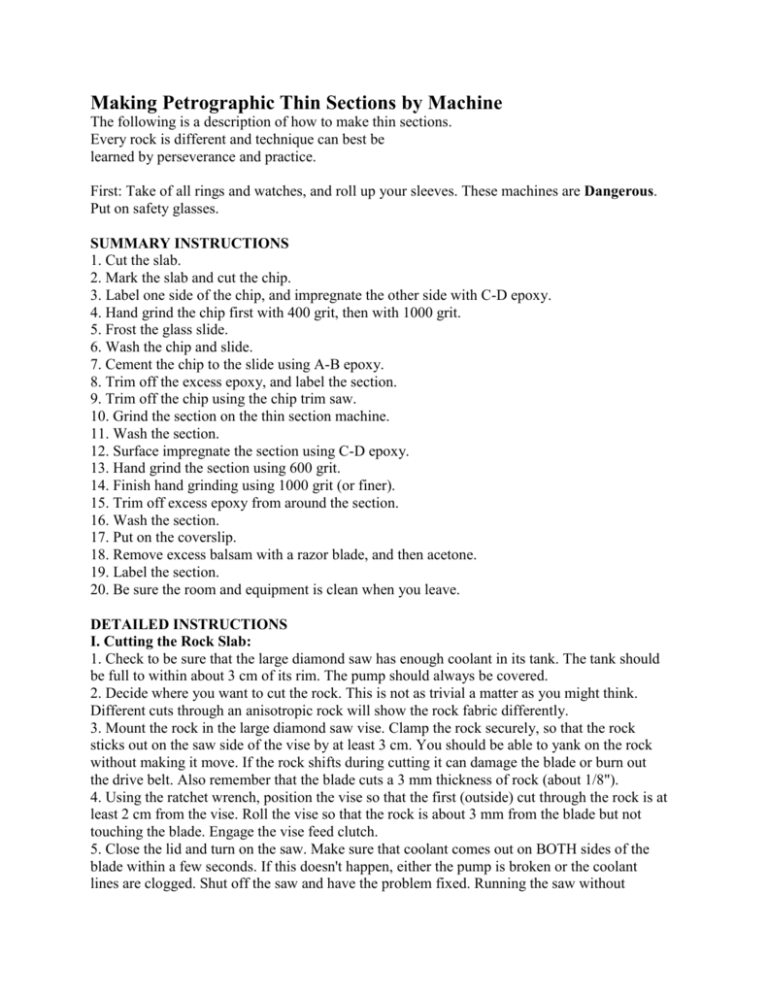
Making Petrographic Thin Sections by Machine The following is a description of how to make thin sections. Every rock is different and technique can best be learned by perseverance and practice. First: Take of all rings and watches, and roll up your sleeves. These machines are Dangerous. Put on safety glasses. SUMMARY INSTRUCTIONS 1. Cut the slab. 2. Mark the slab and cut the chip. 3. Label one side of the chip, and impregnate the other side with C-D epoxy. 4. Hand grind the chip first with 400 grit, then with 1000 grit. 5. Frost the glass slide. 6. Wash the chip and slide. 7. Cement the chip to the slide using A-B epoxy. 8. Trim off the excess epoxy, and label the section. 9. Trim off the chip using the chip trim saw. 10. Grind the section on the thin section machine. 11. Wash the section. 12. Surface impregnate the section using C-D epoxy. 13. Hand grind the section using 600 grit. 14. Finish hand grinding using 1000 grit (or finer). 15. Trim off excess epoxy from around the section. 16. Wash the section. 17. Put on the coverslip. 18. Remove excess balsam with a razor blade, and then acetone. 19. Label the section. 20. Be sure the room and equipment is clean when you leave. DETAILED INSTRUCTIONS I. Cutting the Rock Slab: 1. Check to be sure that the large diamond saw has enough coolant in its tank. The tank should be full to within about 3 cm of its rim. The pump should always be covered. 2. Decide where you want to cut the rock. This is not as trivial a matter as you might think. Different cuts through an anisotropic rock will show the rock fabric differently. 3. Mount the rock in the large diamond saw vise. Clamp the rock securely, so that the rock sticks out on the saw side of the vise by at least 3 cm. You should be able to yank on the rock without making it move. If the rock shifts during cutting it can damage the blade or burn out the drive belt. Also remember that the blade cuts a 3 mm thickness of rock (about 1/8"). 4. Using the ratchet wrench, position the vise so that the first (outside) cut through the rock is at least 2 cm from the vise. Roll the vise so that the rock is about 3 mm from the blade but not touching the blade. Engage the vise feed clutch. 5. Close the lid and turn on the saw. Make sure that coolant comes out on BOTH sides of the blade within a few seconds. If this doesn't happen, either the pump is broken or the coolant lines are clogged. Shut off the saw and have the problem fixed. Running the saw without coolant will ruin the very expensive blade within a few seconds. Do not wander off while the large saw is running. If the blade does jam, turn the saw off as quickly as possible. 6. After the cut is complete, turn off the saw and lift the lid. Don't remove the rock from the vise yet! Disengage the vise feed clutch and roll the vise back from the blade. Using the ratchet wrench, move the vise so that a second (inside) cut through the rock will leave a cut slab 5-15 mm thick. 7. Move the vise up to the blade again, engage the clutch, and make the second cut. When finished, remove the rock and your slab. Always leave the saw lid open when the saw is not in use or it will rust. II. Preparing the Chip: 1. If your rock is friable or full of holes, go to Appendix B first, then come back here. Using a coverslip or a ruler, mark off a coverslip-size area on the rock slab that you want to see in thin section. Several chips can be marked at once on a big slab this way. Remember that the trim saw blade makes cuts about 1.5 mm thick (about 1/16"). 2. Make sure the small trim saw has enough coolant in its tank. Turn on the saw and make sure coolant sprays from the blade on both sides. Put your slab flat on the saw table (break off any rock protrusions if necessary). Align one side of your marked area with the blade, and slowly push the slab into the blade to make your cut. Hold the slab firmly, and try to make the cut as straight as possible. Let the saw cut at its own pace, and don't force it. When finished, make the other three cuts to complete the chip. 3. Wash the chip with detergent and water and dry the chip. Label the back with the sample number using an indelible marker or paint. Don't use enamel paint because it will melt. 4. Cover a hot plate with aluminum foil, and put the chips on the hot plate thin section side up. Set the hot plate to 150° F and let it equilibrate for 30 minutes or so. Use a contact thermometer to check the temperature. 5. Mix a small batch of Hillquist C-D epoxy (see Appendix A). 6. Coat the thin section side of the chip (unlabeled side) with epoxy and let it sit for a minute to soak in. Take the chip off the hot plate and wipe off all excess epoxy. Put the chip back on the hot plate to cure (about 30 minutes). If you don't wipe off the excess epoxy when it is liquid, you will have to grind it off later, which is no fun. 7. Clean off a piece of plate glass and find an area on the glass that is flat. On a flat part of the glass, make a slurry with about one level teaspoon of 400 grit SiC and a little water. Using a circular or figure-8 motion and with moderate pressure, slide the chip around in the grit slurry to grind away the saw marks and the plucked and damaged layer. This can take 1-10 minutes. You will have to practice a bit to get the water/grit ratio correct. Check the flatness and quality of the chip surface frequently by cleaning and drying the chip and holding the chip at a small angle up to a light. Continue grinding until the chip is flat and smooth. 8. Wash the chip and clean the plate glass. Prepare another slurry on the clean glass using 1000 grit SiC, and grind the chip for about 1 minute. The result should be a flat and smooth reflective surface. Check this by holding the cleaned and dried chip at a small angle up to a light. Once a smooth, flat surface on the chip is obtained, your chip is done. III. Preparing the Glass Slide: 1. Glass slides have to be roughened or the epoxy will not stick and your thin section will fall off. Get as many glass slides as you have chips. Check that there is enough coolant in the thin section machine tank. Turn on the coolant pump and vacuum pump and make sure that coolant is coming out onto the cup wheel and that air is being sucked into the vacuum chuck. You may have to adjust the vacuum and coolant line valves to direct the flow to proper places. Turn on the thin section machine. 2. While carefully but firmly holding a glass slide, touch one corner of the slide to the flat surface of the cup wheel for a second or so, just enough to grind off a bit of the corner. This mark will let you orient the slide properly on the machine later. 3. Make sure the vacuum chuck is free of crud and grit. Open the vacuum release valve and put the slide onto the chuck with the ground off corner pointing up. Adjust the micrometer on the machine so that the slide just misses the cup wheel. 4. While moving the chuck gently back and forth, advance the micrometer until the cup wheel starts to grind the glass slide. Continue to advance at a rate of about 1 micrometer increments per 5 passes of the chuck past the cup wheel, for about 20 micrometers. Check the slide and make sure that it is frosted over its entire surface. If it isn't, grind the slide for another 5 increments or so until frosting is complete. Open the vacuum release valve and remove the slide. 5. Write down the number now indicated by the micrometer. You will want to grind the rest of your slides to the same micrometer position. This will give you a reference end point position when you are grinding the thin sections. 6. Open the vacuum release valve and remove the slide. Repeat steps 2-4 for all of the other slides, making sure to grind each to the same micrometer position as the first. If some slides aren't completely frosted at this position, get more slides. Put the partially frosted slides into the "Orphan Slides" box. IV. Cementing the Chip: 1. Clean the chips and glass slides (separately) in the ultrasonic cleaner. Put hot water and a little detergent to a plastic container, put the chips or slides into the container, put the container in the ultrasonic cleaner, and clean the chips or slides for a minute or so. The plastic container keeps the ultrasonic cleaner clean. Take out the chips or slides, scrub them with a clean soapy sponge, rinse thoroughly, and put the chips or slides smooth side down on some paper towels to drain. When most of the water has drained away, transfer them to dry paper towels and leave the chips and slides smooth side down to dry. 2. Cover a hot plate with aluminum foil and set the hot plate to 170° F. Put the chips on the hot plate smooth side up. Don't touch the ground surfaces! Let them heat up and devolatilize for at least 30 minutes. Check the temperature using the contact thermometer. 3. Mix up a small batch of Hillquist A-B epoxy (see Appendix A). 4. Put one of the frosted glass slides frosted side up onto the hot plate to heat up for a minute. First use the wooden stick that you mixed the epoxy with to spread epoxy onto the glass slide. Use a pencil eraser to hold the slide down. Second, coat the smooth side of one chip with epoxy. Put the glass slide onto the chip, epoxy sides together. Use a rounded pencil eraser to work out the bubbles by pressing gently in the middle of the slide and moving the slide in small circles. Move the eraser around to slowly work the bubbles to the edge of the slide until all or most have been worked out. 5. When the bubbles are gone (or as many as possible), move the slide so that it is nearly centered over the chip, with an equal space around three sides of the chip and a larger space at one end for the sample number. Set the chip in an unused part of the hot plate to cure. 6. Repeat steps 4-5 for the rest of the chips. When finished, turn the hot plate down to about 150° C, and let the chips to sit for a few hours to cure. V. Trimming the Chip: 1. When the epoxy has cured, take the hot chips one at a time from the hot plate, and immediately use a sharp razor blade to trim excess epoxy from the edges and bottom of the glass slide. This is important because otherwise the chip will not lie flat in the chuck of the thin section machine. You can trim off hot epoxy much more easily than cold epoxy. Use paper towels or gloves to insulate your hands if the chips are too hot. 2. Use a diamond scribe to write the sample number on the back of the slide, under the wide area of glass at one end. Wash off all of the epoxy trimmings. 3. Turn on the coolant and vacuum pumps and reset the valves so that water and vacuum are directed to the cutoff saw. Make sure there is sufficient coolant flow to both sides of the blade. Open the vacuum release valve and put the glass side of the section onto the vacuum chuck. Adjust the micrometer so that the chip will be cut about 0.5 mm from the slide. Ordinarily the micrometer is preset. 4. Turn on the saw. Slowly and with moderate and even pressure, move the chuck toward the blade to cut off the chip. Ease off on the pressure near the end of the cut. When the chip falls off, bring back the chuck, open the vacuum release valve, and remove the section. 5. Repeat steps 2-4 for the rest of the chips. Turn off the saw before trying to get your trimmed chips out of the saw tank. Rinse off all of your thin sections. VI. Machine Grinding the Thin Section: 1. When you frosted the slides you wrote down the micrometer setting that each slide was ground to. When grinding the thin sections, you will want to machine grind the sections to within about 50 m (25 micrometer increments) of this value. 50 m = 30 for the finished section + 10 for the thickness of the epoxy layer + 10 for hand grinding. Our equipment is not good enough to produce a finished section, and variations in the thickness of the epoxy layer make it necessary to start checking the thickness with the microscope at about 80 m (40 increments) from the original frosted slide end point. 2. Reset the vacuum and coolant valves so that they go to the thin section machine. Turn on the vacuum, coolant, and the machine. Put the first thin section in the vacuum chuck (vacuum release valve open), with the ground off corner pointing up. Using the micrometer, back the chuck away from the cup wheel until the thin section barely misses the wheel. Move the chuck back and forth, advancing the chuck with the micrometer by 5 increments for each 5 passes or so, until the chuck is within one full revolution (200 m, 100 increments) of the final end position described above. Continue advancing the chuck more slowly and with more passes. As you approach the final chuck position, say within 80 m (40 increments) of the frosted slide position, remove the thin section from the chuck, rinse it off, and check the thickness of the section with the microscope. Leave the machine running. 3. Especially check the corners of the section since these are ground off faster than the middle. The thinnest part of the corners should never be ground thinner than having quartz and feldspar with 1st order yellow interference colors. If the section is too thick, put it back on the machine and grind off a little more. Check the section frequently. As the section nears final thickness, you should slow down the advance of the chuck to 1/2 micrometer increment per 5 passes of the chuck. Eventually you will find that one area of the section is as thin as it should get. Write down the micrometer position, because this is approximately the end point for all of the rest of your sections. 4. Remove the section from the machine and wash it off. Repeat steps 2-3 for all remaining sections. Now that you know the micrometer end point for the first slide, you can save time by not having to check the thickness of the others as early. 5. When all sections have been ground on the thin section machine, wash and dry them, and coat the surface of the sections with Hillquist C-D epoxy, as you did the chips in part II-6 above. Be sure to wipe off the excess epoxy. VII. Hand Grinding: 1. On a flat piece of plate glass, make a water slurry with about a level teaspoon of 600 grit SiC. Check with a microscope the thickness of the slide in different parts. The middle is probably the thickest. Put the section rock side down into the slurry and, while pressing on it with your fingers, move the section in circles or figure-8's to grind away the thickest parts. The places where you press the hardest will be the areas that will grind away the fastest. 2. Rinse the section with water and check its thickness at frequent intervals. Always try to grind the thick parts of the section and make an even thickness. Continue until the section has reached a constant thickness and quartz and feldspar has 1st order yellow or yellow-orange interference colors. Repeat steps 1 and 2 for all other sections. 3. Wash the plate glass and make a new slurry on the clean glass with 1000 grit SiC (or 5 m Al2O3 if you want an especially pretty section and don't mind working harder). Again check the thickness of the section in different areas and grind away the last few m of section until the it has an even thickness and quartz and feldspar have no more than 1st order pale yellow or white interference colors. Remember to check the thickness frequently as you grind. Repeat this step for all other sections. 4. When grinding is finished, warm up a hot plate to about 160° F. Allow 30 minutes to equilibrate. Put a thin section on a smooth and flat part of the hot plate, and use a SHARP razor blade to cut away all of the epoxy from the edges of the rock section. Scrape away enough of the rock so that it is slightly smaller than the coverslip so that the rock will later be embedded in Canada balsam when the coverslip is put on. Use an actual coverslip for comparison. VIII. Installing the cover slip: 1. Wash and scrub the thin sections thoroughly using detergent and a clean piece of sponge. Rinse them well and let them drain rock side down on paper towels; then transfer them to new paper towels to finish drying. 2. Set a hot plate to about 220° F, and allow it to equilibrate for about 30 minutes. 3. Put a slide on the hot plate rock side up on a small piece of aluminum foil that has no holes, and let it to heat up for a minute. While holding the slide in place with a pencil eraser, smear some Canada balsam onto the section leaving it relatively thick in the middle. Let it sit for about 2 minutes. 4. After about 2 minutes, carefully put a coverslip on the section and work out the bubbles by gently pressing the coverslip with a rounded pencil eraser while moving the coverslip in small circles. Work the bubbles outward from the middle, while also working out as much balsam as possible. Don't press too hard or you will get vapor bubbles that you won't be able to get rid of. The aluminum foil should catch all of the balsam that slobbers over the edge. 5. When most of the bubbles are gone, center the coverslip over the rock, take the section off the hot plate, and let it to cool. Repeat steps 3-5 for all other sections. 6. When all of the coverslips have been mounted and the slides are cool, put the section on a smooth, flat surface and use a razor blade to scrape away most of the excess Canada balsam. Be very careful not to get the razor under the coverslip or it will peal up. If the coverslip peals up just a little, put the section back on the hot plate and use a pencil eraser to press the gap closed as the slide heats up. 7. Go to a fume hood away from all heat sources or sparks, and use acetone (sparingly) and Kimwipes to wash off the rest of the Canada balsam. If you use too much acetone you will dissolve too much balsam and undermine the coverslip. 8. Your section is now complete! Label it on the wide end with India ink and cover the ink with a thin layer of epoxy, varnish, or colorless fingernail polish to protect it. APPENDIX A: MIXING EPOXY We have three different kinds of epoxy: 1. Hillquist A-B: This is a strong, high viscosity, low index epoxy for gluing chips to slides. Part A is the resin and part B is the hardener. 2. Hillquist C-D: This is a weaker but lower viscosity, higher index epoxy for impregnating small porous samples and surface impregnating thin section chips to inhibit plucking. Part C is the resin and part D is the hardener. 3. Buehler Epoxy: A relatively inexpensive, low viscosity epoxy for impregnating large samples. Directions for Hillquist A-B and C-D Epoxy: Each epoxy liquid is stored in plastic bottles from which the epoxy is extracted using syringes. Each syringe is labeled A, B, C, or D, corresponding to the bottle for which the syringe is to be used. DON'T USE EPOXY SYRINGES FOR ANY BOTTLE OTHER THAN THE ONE FOR WHICH THEY ARE LABELED! Each syringe is marked WITH different size increments called "units", with a maximum of two units for each syringe. Whenever you mix epoxy, use one unit of each of the two liquids, or two units of each of the two liquids. Use whatever size unit the syringe has. This is because the volume ratio of resin to hardener is not 1:1, but is some other ratio that is accurately measured using the proper volume units on the syringes. 1. Take one of the aluminum dishes and blow out any dust. Remove the cap from the part A (or C) epoxy resin bottle, and the cap from the end of the proper syringe. Fully depress the plunger on the syringe. Stick the end of the syringe into the hole in the bottle, and invert the bottle until the cap area is filled and contains no bubbles. Extract one (or two) unit(s) of part A (or C) epoxy resin, and squirt the resin into the middle of the aluminum dish. PULL BACK THE PLUNGER IN THE SYRINGE ALL THE WAY TO THE END! Recap the bottle and the syringe. 2. Remove the cap from the part B (or D) epoxy hardener bottle, and the cap from the end of the corresponding syringe. Fully depress the plunger on the syringe. Stick the end of the syringe into the hole in the bottle, and invert the bottle until the cap area is filled and contains no bubbles. Extract one (or two) unit(s) of part B (or D) epoxy hardener, and squirt the hardener onto the resin in the aluminum dish. PULL BACK THE PLUNGER IN THE SYRINGE ALL THE WAY TO THE END! Recap the bottle and the syringe. 3. Use a wooden stick to mix the epoxy parts thoroughly together. Try not to trap bubbles as you stir. Put the aluminum dish on a hot plate for a few seconds to lower the viscosity and help the components mix. Your epoxy is now ready to use. Buehler Epoxy: 1. Get a container to mix the epoxy in. The Buehler graduated paper cups are probably the easiest to use because they have volume measures already marked on them. If you want to be more accurate, use a balance and weigh the components. 2. The Buehler epoxy is supposed to be mixed by weight, but the two epoxy parts have almost the same density so volume measurements are probably fine If you do it accurately. Mix the epoxy parts by weight or volume as follows: 3. For curing at room temperature, mix 5 parts resin to 1 part hardener. Allow 6-8 hours to cure at 70° F, or more time if cooler. For curing at 120-150° F mix 6 parts resin to 1 part hardener. Allow 2 hours or so to cure, and then let cure for another 4 hours at room temperature to minimize shrinkage. APPENDIX B: VACUUM IMPREGNATING Porous or friable rocks have to be vacuum impregnated with epoxy or polyester resin so they hold together when they are cut and ground, and so grinding grits of don't get into all of the holes. 1. It is generally best to prepare friable or porous samples by first cutting them into pieces about the size of a thin section chip (about 3.5 x 2.5 x 1.5 cm). Most friable samples contain excess water in between grains, adsorbed on clays, in zeolites, and elsewhere. Drive off the excess water by heating the samples on a 200° F or hotter hot plate for 30 minutes or more. 2. Get out the vacuum bell jar and make sure the gasket and gasket slot is clean and free of dust and epoxy. Connect the bell jar to the vacuum hose using the plastic connectors. 3. Use the switch on the thin section machine to turn on the vacuum pump, and turn the valves so that the vacuum pump is drawing from the bell jar. Turn the stopcock on the bell jar so that the vacuum pump evacuates the vacuum line (vacuum pumps don't like to pump large volumes of air). 4. Mix enough epoxy (see Appendix A) for all of the samples that you will be putting in the bell jar at one time. Put the samples in cups or dishes and make sure they are completely covered with epoxy. Put the samples into the vacuum jar and put on the lid. 5. Open the stopcock so that the vacuum pump draws air out of the bell jar. Bubbles in the epoxy will immediately swell and burst, and bubbles of air will come streaming out of pores in the rock. After a minute or two, the air pressure will become low enough so that the epoxy boils. Let it boil for a few seconds, then turn the stopcock and let air back into the bell jar. Air pressure forces liquid epoxy into the pores of the evacuated sample, hopefully cementing everything together. Let the samples sit at atmospheric pressure for 30 seconds or so, and repeat the evacuation cycle two more times. Each cycle takes about 2 minutes. 6. When finished, remove the samples from their epoxy baths and remove the excess epoxy. Cure the epoxy at room temperature or on a hot plate according to the epoxy instructions in Appendix A. When cured, you may want to cut a nice flat surface using the small diamond saw.
